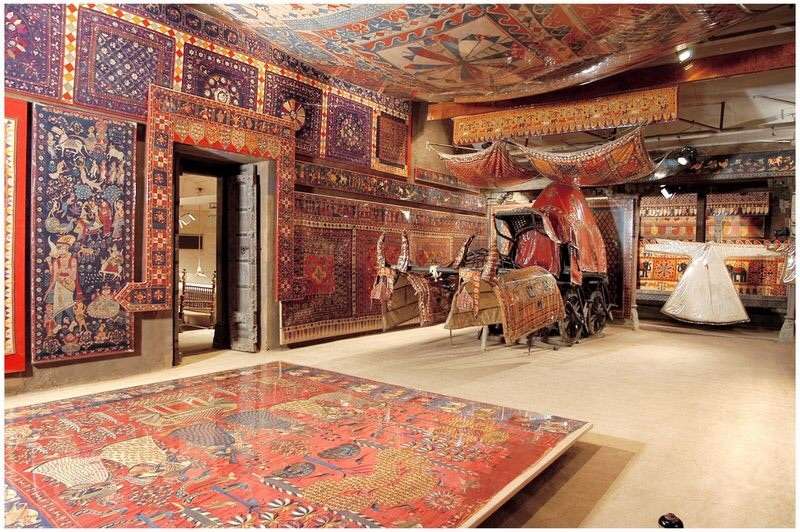The Calico Museum of Textiles, part of the Sarabhai Foundation, is recognized as the top textile gallery in India. Its collection of Indian textiles is widely regarded as the best and most extensive globally. Moreover, the museum showcases an impressive array of South Indian bronzes, Vaishnava picchavais, Jain art, and small paintings from the Sarabhai Foundation. All these treasures are exhibited at The Departure, situated in the Shahibaug area of Ahmedabad. The foundation offers daily museum tours and a variety of books on textiles and other topics. Remember to schedule an appointment before your visit, and please note that phones and cameras are not permitted inside.. Being one of the oldest galleries in Ahmedabad, this place never ceases to captivate visitors with its extensive collection of rare textiles, fabrics, and artifacts from all over the country.
Timing: 10:30 am to 1pm
The Calico Museum of Textiles, part of the Sarabhai Foundation, is recognized as the top textile gallery in India. Many regard its collection of Indian textiles as the most exquisite and extensive worldwide. Located in the Shahibaug area of Ahmedabad, The Departure is where these valuable treasures are displayed. The foundation arranges daily museum tours and offers a wide range of books on textiles and various other topics. It is essential to make an appointment before your visit, and please be aware that phones and cameras are not allowed inside. Following the tour, you can also enjoy some tasty snacks. Being one of the oldest galleries in Ahmedabad, this venue never ceases to captivate visitors with its wide array of rare textiles, fabrics, and artifacts from all corners of the country.
I had the privilege of staying here and experiencing the rich heritage of Gujarati textiles, vintage attire, intricate fabric works, and one-of-a-kind art pieces crafted by esteemed families like Patan Ka Patola and Mata Ni Pachedi. The exhibition also showcases the traditional clothing styles of nobles and kings. Moreover, you can explore mats, wall hangings, hand fans, and much more. The museum also highlights forgotten art forms such as wood carving, decorative home items, and artistic instruments. You can witness the block lithography process and its stunning results on fabric. I highly recommend Amdavadis to visit this gallery, but remember to register beforehand. Every aspect, from the museum’s architecture to its content, has been meticulously examined. This museum proudly houses an extraordinary collection of paintings, embroidery, sculptures, and bronze artifacts.
Modification and improvements of museum
The Calico Museum of Textiles stands out from traditional museums by rejecting the clinical and disconnected atmosphere often found in them. Instead, it embraces a vibrant and interconnected approach that celebrates India’s rich heritage. By encouraging a holistic view and fostering connections, the museum showcases the cultural intricacies of India through three distinct geographical themes in its displays.
Role Of Museum
1. The innovative display techniques are elegantly presented, featuring a flexible, lightweight, and modular approach. This results in a harmonious blend of textures, colors, and images, where each element seamlessly transitions into the next, creating a continuous flow akin to a majestic river.
2. The exhibits captivate the audience, erasing any sense of distance. By minimizing barriers between the viewer and the artifacts, a deeper connection is forged.
3.The carefully selected items are showcased without a strict hierarchy, inviting visitors to freely explore the exhibits from different perspectives. This departure from the traditional museum setup provides a more emotionally engaging experience, capturing the essence of India’s rich artistic and cultural heritage in a distinct manner.
History Of This Museum:
The Calico Museum of Textiles was previously situated within the Calico Mills complexes in Ahmedabad. Nevertheless, in 1982, it was relocated to the Shahibaug premises of the Sarabhai Foundation. The fresh site, referred to as The Retreat to the Sarabhai family, houses the remarkable Sarabhai-ni-Haveli, which was crafted by Surendranath Kar from Shanti Niketan during the 1930s. The Calico Museum of Textiles was once a part of the Calico Mills complexes in Ahmedabad. However, in 1982, it was transferred to the Shahibaug premises of the Sarabhai Foundation. The new spot, known as The Retreat to the Sarabhai family, is where the impressive Sarabhai-ni-Haveli, designed by Surendranath Kar from Shanti Niketan in the 1930s, is located..
This grand haveli features a beautiful garden and water elements. The area also includes a cluster of buildings surrounding an old swimming pool, all adorned with intricately carved wooden facades inspired by traditional Gujarati architecture. These buildings are centered around a courtyard or ‘chauk’. As a result of the move, the Calico Museum of Textiles and the Sarabhai Foundation now have two wings. The ‘Haveli’ houses religious textiles, south Indian bronzes, Jaina art, and Mughal and other miniature paintings. On the other hand, the ‘Chauk’ stores royal tents, carpets, furnishings, and costumes from the Mughal and regional courts. It also holds textiles for India’s export trade and a diverse collection of ethnographic textiles.




